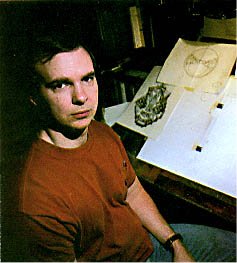 Richard Corben (born October 1, 1940) is an American illustrator and comic book artist best known for his comics featured in Heavy Metal magazine. He is the winner of the 2009 Spectrum Grand Master Award.
Richard Corben (born October 1, 1940) is an American illustrator and comic book artist best known for his comics featured in Heavy Metal magazine. He is the winner of the 2009 Spectrum Grand Master Award.
Richard Corben was born on a farm in Anderson, Missouri, and went on to get a Bachelor of Fine Arts degree from the Kansas City Art Institute, in 1965.
After working as a professional animator, Corben started doing underground comics, including Grim Wit, Slow Death, Skull, Rowlf, Fever Dreams and his own anthology Fantagor.In 1970 he began illustrating horror and science-fiction stories for Warren Publishing.His stories appeared in Creepy, Eerie, Vampirella, 1984 and Comix International. He also colored several episodes of Will Eisner’s Spirit.
In 1975, when Moebius, Druillet, and Jean-Pierre Dionnet started publishing the magazine Métal Hurlant in France, Corben submitted some of his stories to them. He continued his work for the franchise in America, where the magazine was called Heavy Metal. In 1976 he adapted a short Robert E. Howard story in an early graphic novel, Bloodstar.
Eerie ’86 cover by Corben featuring a scene from his story “Change… Into Something Comfortable”
Among the stories drawn for Heavy Metal he continued the saga of his most famous creation, Den which had begun in the short film Neverwhere (Neil Gaiman used the same title, Neverwhere, later, but the two creations have nothing common) and a short story in the underground publication Grim Wit #2. The saga of Den is a fantasy series about the adventures of a young underweight nerd who travels to Neverwhere, a universe taking inspirational nods from Robert E. Howard’s Hyborian Age, Edgar Rice Burroughs’s Barsoom and H. P. Lovecraft’s horror dimensions. There, the boy becomes an enormously endowed nude muscleman who has erotic adventures in a world of outrageous dangers, hideous monsters, and buxom nude women who lustfully throw themselves at him. This story was adapted in a highly abridged form in the animated film Heavy Metal, where Den was voiced by John Candy.
Corben’s collaborations are varied, ranging from Rip in Time with Bruce Jones, to Harlan Ellison for Vic and Blood, to the Den Saga, the Mutant World titles, Jeremy Brood, and The Arabian Nights with Jan Strnad.
From 1986–1994 Corben operated his own publishing imprint, Fantagor Press. Among the titles Fantagor published were Den, Den Saga, Horror in the Dark, Rip in Time, and Son of Mutant World. Fantagor went out of business after the 1994 contraction of the comics industry.
Meatloaf’s Bat out of Hell is a well-known album cover by Richard Corben.
Due to the sexual nature of Corben’s art, it has been accused of being pornographic, a description he himself disagrees with. One notorious example was the interview he gave Heavy Metal editor Brad Balfour in 1981. Corben was very dissatisfied with the interview. He felt it portrayed him as a “petty, childish, borderline psychotic oaf”. He wrote a letter in retort, which was published in the September 1981 issue.
Neverwhere, 1978. This is the first Den comics collection, cover art by Corben.
Corben did the cover of Meat Loaf’s Bat out of Hell, Jim Steinman’s, Bad for Good and a movie poster (based on a drawing by Neal Adams) for the Brian De Palma film Phantom of the Paradise. In addition, he provided cover art for the VHS release of the low-budget horror film Spookies.
In 2000, Corben collaborated with Brian Azzarello on five issues of Azzarello’s run on Hellblazer (146-150) which was collected in a trade called Hellblazer: Hard Time. He also adapted the classic horror story The House on the Borderland by William Hope Hodgson for DC’s Vertigo imprint.
In 2001, Azzarello and Corben teamed up to create Marvel’s Startling Stories: Banner (a four issue mini-series exploring Doc Samson’s relationship with Bruce Banner) and Marvel Max’s Cage (a five issue mini-series starring Luke Cage).
In June 2004, Corben joined with Garth Ennis to produce The Punisher: The End, a one-shot title for Marvel published under the MAX imprint as part of Marvel’s The End series. The story tells of The Punisher’s final days on an earth ravaged by nuclear holocaust.
Ever the independent, Corben would work with rocker Rob Zombie and Steve Niles in 2005 on a project for IDW Publishing called Bigfoot. The graphic series ran for five issues and demonstrates the artist’s evolution. The story chronicles a young boy who witnesses the brutal slaughter of his parents by the enigmatic title character and his return to the forest for revenge when he becomes older.
In 2007, Corben did a two issue run on Marvel Comics’ surreal demon biker, Ghost Rider. At Marvel’s MAX imprint he has produced Haunt of Horror, mini-series adapting classic works of horror to comics. The first mini-series, published in 2006, was based on the stories of Edgar Allan Poe followed by a second series in 2008 adapting works by H. P. Lovecraft. Between 2008 and 2009 he illustrated the flashback sequences in Conan of Cimmeria #1-7, collected as Conan Volume 7: Cimmeria. In 2009 he illustrated Starr the Slayer for Marvel’s MAX comics imprint.
His latest work was serving as animator on the upcoming computer game DARKSTAR – The Interactive Movie.
Awards
Corben’s work in comics and animation has won him recognition, including the Shazam Award for Outstanding New Talent in 1971, and a Shazam Award for Superior Achievement by an Individual in 1973. He also received a CINE Golden Eagle and President of Japan Cultural Society trophy in 1968 for his short film Neverwhere. While working for the Warren anthologies, he received numerous Warren Awards: 1973 Best Artist/Writer and Special Award for Excellence, 1976 Best Art: Within You, Without You, Eerie #77 and Best Cover: Eerie #77 and 1978 Best Cover Artist.


2 Comments